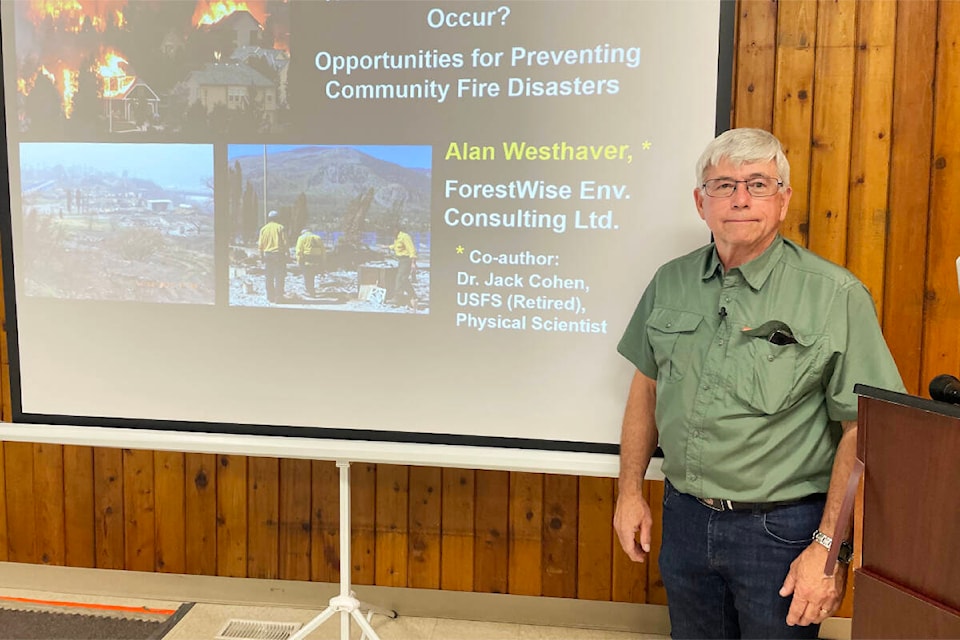Quesnel residents concerned about wildfire impacting communities have the chance to meet the man who wrote the book on how to protect your property.
Community Wildfire Preparedness Roundtables around the region are hosting FireSmart presentations by Alan Westhaver MSc., a 30-year veteran of wildland fire, now a wildland-urban expert.
Westhaver and his fellow fire researcher Dr. Jack Cohen, a world-renownedfire physicist with the U.S. Forest Service, recently completed a report on the Lytton Creek fire which destroyed that community in 2021 which focused on how homes ignited, and how fire then spread throughout the community.
What Westhaver had to say may surprise many members of the public.
“We’ve long considered this to be a wildfire control problem however, it is really a problem of so many homes and structures being so easily ignited,” he states in his presentation. Instead, he emphasized the answer to saving urban areas from these disasters will not come from more planes, helicopters or tanker trucks, but from mostly small measures property owners can take, over time, to make buildings less susceptible to igniting and burning.
He also emphasizes fire is an essential part of nearly all Canadian ecosystems and landscapes.
As we attempted to exclude fire from the landscape, we have changed the land, allowing dense forests with more fuel to develop, causing more potential for extremely intense, catastrophic wildfires which pose a high risk to people and property. Although wildfires are inevitable, evidence provided by Westhaver shows that wildland-urban disasters are not.
Westhaver literally “wrote the book” on FireSmart - how to prepare your home and property to be wildfire-resistant. Westhaver helped develop the original FireSmart manual in 1996 and FireSmart is now a national program to educate homeowners on reducing wildfire hazards to property. The manual, available online, walks you through the process and how to assess your property.
Westhaver will be at the seniors centre in Quesnel May 29 at 6 p.m. and at Clearwater Secondary on May 31 at 6 p.m.
While many in the public may have the idea a large out-of-control wildfire coming towards urban areas is an “unstoppable force” or some sort of monster which will consume homes and properties no matter what, Westhaver has done years of research and knows there is a lot we can do to reduce risks to property.
He has studied many of the large urban-wildfire disasters including the Fort MacMurray fire which destroyed 2,400 buildings in that community, over 2,000 of which were homes.
His research looked at how the fires entered those communities and led to such wide-spread destruction, and it backs up the principles of FireSmart, which emphasize how residents can do a lot to reduce the risk of disaster.
Analysis of the Lytton disaster proved it followed the pattern of all similar disasters, a chain-reaction of events which only occurs during wildfires of the most extreme intensity, when the limits of fire control are exceeded. Nonetheless, that sequence can be broken by making our homes and properties more resistant to ignition. Another surprise, most of the actions required to eliminate vulnerabilities and reduce risk are small, easily achieved, and inexpensive… they do make a big difference to home survival.
Westhaver’s study of Fort MacMurray showed 81 per cent of the homes he looked at which were not destroyed in Fort MacMurray were FireSmart -that is they were properties which adhered to the basic principles of fire prevention for FireSmart, reducing fuels around the house which could combust as a result of radiant heat and ember showers.
Two-thirds of the homes lost were found to have likely had extreme hazard ratings according to FireSmart principles.
Buildings ignited as a result of embers, which set fire to fine fuels which had accumulated in eaves troughs or roof valleys, or which existed as part of landscaping. Once one building in a subdivision catches on fire, adjacent buildings are much more likely to burn.
In urban settings, Westhaver said it is important to work together and take a neighbourhood approach to FireSmarting properties.
Aside from checking the BC FireSmart web site, he strongly recommends that residents act now to:
- Find and remove accumulations of leaves, needles and other easily ignited debris from nooks and crannies on, under and around all buildings on their property.
- Eliminate, store inside, or relocate (more than 10 metres away), all concentrations of flammable materials, machinery, ATV’s and firewood.
- Trim and space all flammable shrubs and trees around your home, favouring fire-resistant broad-leaved trees. Gather and remove dead vegetation, leaves and needles below them.
- Remove ornamental junipers, cedars and ground pine from aground the home, they burn with great intensity.
- Establish a 1.5 metre wide “non-combustion zone” immediately around the perimeter of all homes, including any flammable attachments such as stairs, decks, porches and landings.
The FireSmart Manual can be downloaded at: https://homeowners-manual.firesmartbc.ca/
READ MORE: New wildfire in West Chilcotin estimated at 86 hectares
READ MORE: Helicopters and layer of smoke help in fight against northeastern B.C. wildfire
Do you have a comment about this story? email:
ruth.lloyd@wltribune.com
Like us on Facebook and follow us on Twitter.
